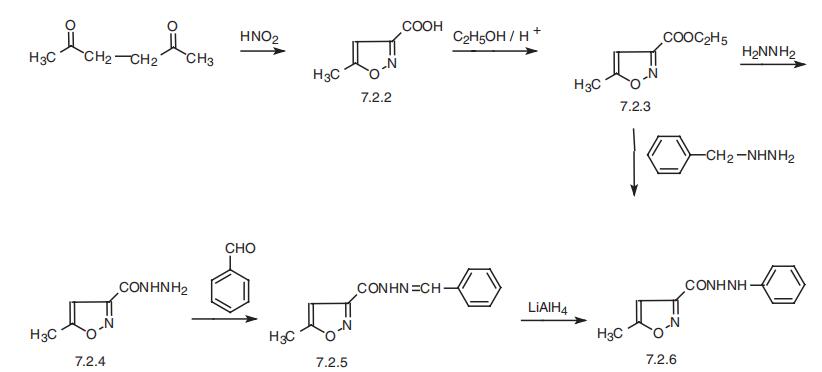| Identification | Back Directory | [Name]
ISOCARBOXAZID (200 MG) | [CAS]
59-63-2 | [Synonyms]
Bmih
Enerzer
Marplan
Marplon
Benazide
Maraplan
ro5-0831
Ro 5-0831
NSC 169893
Ro 5-0831/1
Isocarboxyzid
Isocurboxazid
Isocarboxizid
isocarboxazid
Isocarbonazid
Isocarboxazide
Isocarbossazide
ISOCARBOXAZID (200 MG)
N'-Benzyl-5-methyl-3-isoxazolecarbohydrazide
3-(N-Benzylhydrazinocarbonyl)-5-methylisoxazole
N'-(benzyl)-5-methyl-isoxazole-3-carbohydrazide
n’-benzyln-methyl-5-isoxazolecarboxylhydrazide-3
N'-Benzyl N-methyl-5-isoxazolecarboxylhydrazide-3
5-methyl-3-isoxazolecarboxylicaci2-benzylhydrazide
5-methyl-3-isoxazolecarboxylicacid2-benzylhydrazide
1-Benzyl-2-(5-methyl-3-isoxazolylcarbonyl)hydrazine
1-benzyl-2-(5-methyl-3-isoxazolyl-carbonyl)hydrazine
5-Methyl-3-isoxazolcarboxylic acid 2-benzylhydrazide
5-Methyl-3-isoxazolecarboxylic acid 2-benzylhydrazide
5-methyl-N'-(phenylmethyl)-1,2-oxazole-3-carbohydrazide
3-Isoxazolecarboxylic acid, 5-methyl-, 2-benzylhydrazide
3-Isoxazolecarboxylic acid, 5-methyl-, 2-(phenylmethyl)hydrazide | [EINECS(EC#)]
200-438-4 | [Molecular Formula]
C12H13N3O2 | [MDL Number]
MFCD00865409 | [MOL File]
59-63-2.mol | [Molecular Weight]
231.251 |
| Chemical Properties | Back Directory | [Appearance]
Pale Yellow Solid | [Melting point ]
98-1000C | [Boiling point ]
373.33°C (rough estimate) | [density ]
1.206 | [refractive index ]
1.5290 (estimate) | [storage temp. ]
-20°C Freezer | [solubility ]
Acetonitrile: Slightly Soluble; Chloroform: Slightly Soluble | [form ]
A solid | [pka]
pKa 10.4 (Uncertain) | [color ]
White to off-white | [Water Solubility ]
0.8g/L(25 ºC) |
| Hazard Information | Back Directory | [Chemical Properties]
Pale Yellow Solid | [Uses]
Monoamine oxidase inhibitor. Antidepressant | [Originator]
Marplan,Roche,US,1959 | [Definition]
ChEBI: 5-methyl-N'-(phenylmethyl)-3-isoxazolecarbohydrazide is a member of benzenes. | [Manufacturing Process]
800 g of benzaldehyde was added to a hot solution (75°C) of 7 liters of
ethanol containing 720 g of 5-methyl-2-isoxazole carboxylic acid hydrazide.
The solution was stirred for ten minutes at which time the product began to
crystallize. On cooling at 4°C for 14 hours, the solid was filtered off under
vacuum and the solid filter cake was washed twice using 250 ml of ice cold
ethanol for each washing. The lbenzylidene-2-(5-methyl-3-isoxazolylcarbonyl)
hydrazine was recrystallized from ethanol, MP 199°C to 200°C.
115 g of 1-benzylidene-2-(5-methyl-3-isoxazolylcarbonyl)hydrazine was added
portionwise over the period of an hour to 5 liters of anhydrous ether
containing 18.5 g of lithium aluminum hydride. The reaction mixture was
stirred for four hours and permitted to stand overnight. The excess lithium
aluminum hydride was decomposed with 250 ml of ethyl acetate and 150 ml
of water was added to decompose the complex. The solid was separated by
filtration and the ether layer was concentrated to about 500 mi. 200 ml of
benzene was added to dehydrate the solution. Concentration was continued
until a solid remained. The 1-benzyl-2-(5-methyl-3-isoxazolylcarbonyl)
hydrazine was recrystallized from methanol, MP 105°C to 106°C. | [Brand name]
Marplan (Oxford). | [Therapeutic Function]
Antidepressant | [World Health Organization (WHO)]
Isocarboxazid, a monoamine oxidase inhibitor (MAOI), was
introduced in 1959 for the treatment of depressive illness. Subsequently concern
regarding potentially serious interactions between MAOIs and foods containing
tyramine inspired much restrictive regulatory action. However, MAOIs still retain a
place in the treatment of serious depressive illness although there is no
international consensus on which compounds should be preferred. Thus
isocarboxazid remains available in several countries and is cited in the British
National Formulary as a relatively safe example of this class of compound. | [Synthesis]
Isocarboxazid, 2-benzylhydrazid-5-methyl-3-isoxazolecarboxylate (7.2.6),
can be synthesized from acetylacetone, which on nitrosation with nitrous acid gives 5-
methyl-isoxazol-3-carboxylic acid (7.2.2). Esterification of this product gives the ethyl
ester of 5-methyl-isoxazol-3-carboxylic acid (7.2.3). The synthesized ester (7.2.3) is fur�ther reacted with benzylhydrazine, to give isocarboxazide (7.2.6), or with hydrazine,
which forms 5-methyl-isoxazol-3-carboxylic acid hydrazide (7.2.4). Reacting the latter
with benzaldehyde gives hydrazone (7.2.5), which is further reduced to the isocarboxazide
(7.2.6) [46,47].
| [storage]
Store at -20°C |
|
|